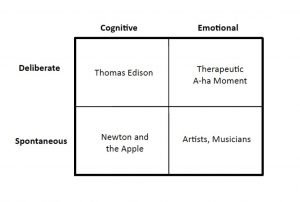If you’ve ever assumed that the world is split into logically minded people that are good at maths and science, and creative people that are good at art and writing, then it’s time to reconsider.
Ever heard of the idea that there are two types of thinkers – the left-brained analytical thinkers and the right-brained creative thinkers? This may be a myth, as research has shown that we don’t actually have a dominant side of the brain.
4 types of creativity
The Psychologist, Arne Dietrich, identified 4 types of creativity in a 2004 study:
Deliberate and cognitive – using your existing knowledge and expertise to work for a long period of time on a specific problem. Dietrich gave the example of Thomas Edison, who conducted thousands of experiments before landing on the invention of the lightbulb.
Deliberate and emotional – this involves deliberately reflecting on your emotions to come up with a solution to a problem. Often associated with epiphanies or sudden moments of self-discovery, this is the type of creativity that helps us work through personal problems.
Cognitive and spontaneous – Ever worked really hard on a logical problem, only to stop for a break and have the solution come crashing down from nowhere? Cognitive and spontaneous creativity lets the unconscious brain do its work, much like Isaac Newton and his discovery of the laws of gravity.
Spontaneous and emotional – this is the type of creativity we most commonly think of. Spontaneous and emotional creativity is something artists and musicians tap into, but something we are all capable of using (we’ll get to how in a minute).
Benefits of being creative
Why should you try and increase your creative output?
Problem solving – Thinking creatively can help you solve problems and come up with new ideas at work and in your personal life. It drives innovation and progression.
Relives stress – Engaging in creative activities in your leisure time lowers your stress levels and improves your overall mental wellbeing, which in turn reduces the likelihood of developing diseases such as depression, heart disease and Alzheimer’s.
Learning ability – Studies have shown that if you engage in creative activities, or learn a new creative skill, it increases your ability to learn in other capacities too, in effect exercising your brain to make it better at retaining information and skills.
Life satisfaction – When you do things you enjoy, it stimulates the part of the brain that controls mood and energy levels, which in turn increase overall life satisfaction.
Self-esteem and confidence – “Feeling that you are solely defined by your job – even if it is going well – can raise your chances of experiencing anxiety, depression and burnout, because you may not have a perception of yourself outside of work,” says Psychotherapist Michelle P. Maidenberg.
How to tap into your creativity
American business magazine Inc.com gives several ways in which you can unleash your creative side:
- Doodle something
Far from demonstrating a lack of focus, doodling can actually stop your mind from drifting and help jumpstart creativity by unlocking new insights.
- Sign up for a class
Getting out of your comfort zone is ideal for getting your creative juices flowing. It helps you to use different parts of your brain, as well as relieving stress. Explore our creative courses here
- Create the right environment
Companies like Google go to great lengths to provide employees with fun perks such as beach volleyball courts and even free beer, a setup almost resembling “an adult playground”. This is because creativity flourishes in relaxed environments where ideas, even wacky ones, are celebrated.
- Move your body
Going for a walk or trying a new sport not only gives you more energy, but gives your subconscious an opportunity to work on those spontaneous cognitive breakthroughs.

